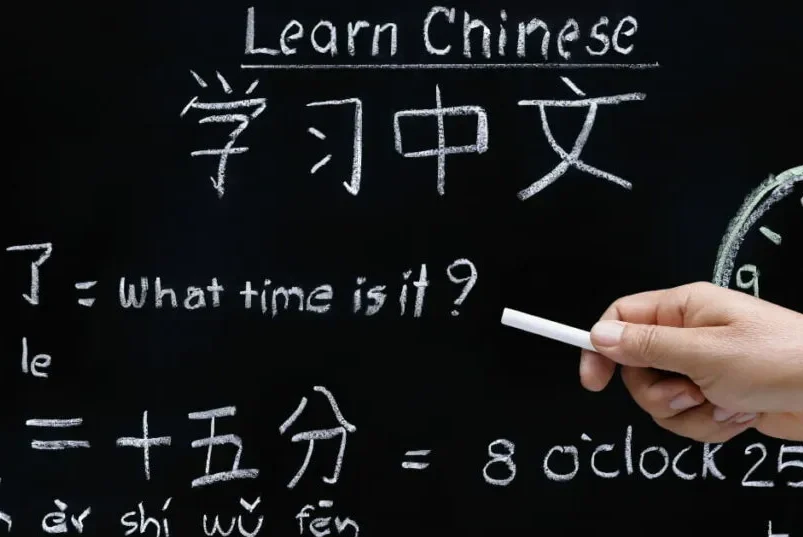Is mandarin hard to learn? Understanding the Challenges and Advantages

¿Is mandarin hard to learn? This is the official language of China, the largest nation in the world, with a huge population that makes this language the most spoken.
But in light of this and the importance of speaking this language, ¿Is mandarin hard to learn? The answer is not simple, and we are dealing with a linguistic system that seems complex, but to understand this, we need to learn a bit about the language.
¿Is mandarin hard to learn?
The most specific fact is that the Chinese language is spoken by over a billion people worldwide, making it the second language with the most users globally.
On the other hand, it is the language with the most native speakers: nine hundred million.
Mandarin is also known as “zhong wen,” “han yu,” or “pu tong hua.” In Taiwan, Hong Kong, and Macau, it is also called “Guo Yu.”
In Singapore, Malaysia, and Indonesia, it is known as “hua yu.” Mandarin or Chinese is based on the Beijing variety of Mandarin, “beijinghua.”
This language belongs to the large Sino-Tibetan language family, which also includes other languages spoken in China, such as Cantonese, Hakka, Xiang, Wu, among others.

¿Is mandarin hard to learn?
Mandarin has the following linguistic characteristics and, syntactically, is an analytic language. It has a subject-predicate structure (我吃饭 – I eat) or verb-object structure (看书 – read book).
Morphologically, Chinese has very basic characteristics and is less complex than inflectional languages like Spanish or French.
For example, it lacks plural, tense, mood, or gender morphemes. However, each morpheme can be considered a character. A morpheme can also be considered a word, for example, 水 (water).
If you like learning more about foreign cultures, you can read more at Todaylat: Discover the Magic of Mexico’s Pueblos Mágicos.
Chinese writing has existed for over 5,000 years and is one of the oldest in the world still in use today.
The first Chinese emperor, Qin Shi Huang, who founded the Qin dynasty in 221 B.C., unified Chinese writing.
Initially, characters represented natural phenomena like the shapes of the sun, moon, stars, or animal tracks in the sand.
Gradually, these characters evolved through different dynasties into what is known today as ideograms (Wong Torres, 2004).
Chinese characters can be classified into different categories. For example, pictograms are characterized by stylized representations of concrete objects with fixed traits, like the character 火 (fire).
Ideograms are characterized by graphic representations of abstract concepts, such as the character 下 (below).
Read more: A DOJ lawsuit: TikTok may influence elections.
Up to this point, it seems the answer to “¿Is mandarin hard to learn?” is complex.
Compound ideograms are represented as symbolic graphics of objects and more elaborate concepts.
In a way, it is a combination of two or more characters to create a new one, such as the character 休 (rest), which is composed of the characters for person and tree.
¿Why is mandarin hard to learn?
According to Linguaserve, this dialect represents the branch of Chinese spoken in the north, central, and southwest regions of the Asian country, and it becomes the most complicated due to the following factors:
- Characters
- Tones
- Writing system
- Pronunciation
Regarding the mentioned characteristics, it is important to highlight that Mandarin Chinese, like English, is one of the most spoken languages in the world.
However, its complexity lies in its more than 100,000 characters, as well as the 5 tones, including the neutral one, and the writing system divided into two variants: simplified and traditional.
Basic elements of Mandarin Chinese:
- It has over 1.1 billion speakers (mostly native)
- It is the main spoken form of Chinese
- It has the largest number of native speakers and total speakers in the world
- This language is spoken in other countries due to the large number of Chinese immigrants
The difficulty in learning Mandarin Chinese is explained by the 5 existing tones for pronunciation, which can be almost imperceptible.
Therefore, you need to achieve perfect intonation when speaking to be understood.

Elements that make Mandarin complex: is mandarin hard to learn?
Phonetic compounds result from the combination of a visual meaning element and a phonetic character, such as the character 蹬 (dēng – to step), which includes the meaning 足 (zú – foot) and the phonetic component 登 (dēng – to ascend).
It is also important to mention that each character has a defined number of strokes, which can range from one to more than fifty, and must be written in a fixed order. Altering this order can be considered a spelling mistake.
Another important feature of Chinese is the tonal system. A tone change in a word can alter its meaning. Mispronunciation of the tone can hinder adequate communication or cause misunderstandings.
Mandarin Chinese has four tones:
- The first tone is high and steady, graphically represented by a horizontal line above the vowel (-).
- The second tone is rising and is represented by an upward line on the vowel (´).
- The third tone starts low, dips down, and then rises, shown as an inverted circumflex on the vowel (ˇ).
- The fourth tone is falling, illustrated by a downward line (`).
- There is also a fifth tone, which is neutral, characterized by being light and brief, without any graphical mark.
Finally, this language mirrors Chinese mentality and customs. The particularities of the language reflect some of the country’s customs.
Basic elements in Chinese writing:
The common idea that learning Chinese means memorizing three to four thousand entirely foreign characters makes the language seem impossible to learn. Fortunately, this idea is also completely false.
Logographic writing contrasts strongly with phonetic writings (alphabets) used by practically all Western languages.
In most phonetic writings, approximately two dozen symbols are used to represent all the sounds and words of the language.
This makes memorizing and verbalizing words much easier.
On the other hand, Chinese is more closely related to pictographic writing (think of Egyptian hieroglyphs), which means there are a large number of characters to memorize.
In fact, to be considered literate, one should be able to recognize around 3,500 simplified characters, not to mention traditional Chinese characters.
Would it be is mandarin hard to learn?
There are a large number of Chinese learning resources available to make learning Chinese a much more enjoyable process.
Some examples are Pleco, Clozemaster, Memrise, YouTube channels, etc.
But for the knowledgeable, the easiest and fastest way to achieve the conversational fluency that most students seek is to immerse themselves in the language, and the best way to immerse oneself is to learn Chinese in China.






